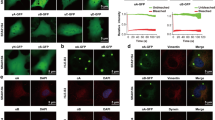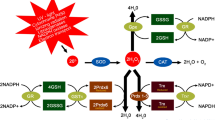Abstract
Studies of molecular mechanisms of chaperone-like activity of α-crystallin became an active field of research over last years. However, fine interactions between α-crystallin and the damaged protein and their complex organization remain largely uncovered. Complexation between α- and βL-crystallins was studied during thermal denaturation of βL-crystallin at 60°C using small-angle X-ray scattering (SAXS), light scattering, gel-permeation chromatography, and electrophoresis. A mixed solution of α- and βL-crystallins at concentrations about 10 mg/ml incubated at 60°C was found to contain their soluble complexes with a mean radius of gyration ∼14 nm, mean molecular mass ∼4 MDa and maximal size over 40 nm. In pure βL-crystallin solution, no complexes were observed at 60°C. In SAXS studies, transitions in the α-crystallin quaternary structure at 60°C were shown to occur and result in doubling of the molecular weight. This suggests that during the temperature-induced denaturation of βL-crystallin it binds with modified α-crystallin or, alternatively, βL-crystallin complexation and α-crystallin modifications are concurrent. Estimates of the α-βL-crystallin complex size and relative contents of α- and α-βL-crystallins in the complex suggest that several α-crystallin molecules are involved in complex formation.
Similar content being viewed by others
REFERENCES
Molecular and Cellular Biology of the Eye Lens. 1981. Ed. Bloemendal H. N.Y.: Wiley.
Harding J.J. 1997. Lens. In: Biochemistry of the Eye. Ed. Harding J.J. London: Chapman and Hall, pp. 94-135.
Bloemendal H. 1982. Lens proteins. CRC Critical. Rev. Biochem. 12, 1-39.
Graw J. 1997. The crystallins: genes, proteins and diseases. Biol. Chem. 378, 1331-1348.
Bloemendal M., Bloemendal H. 1995. The isolation of lens crystallins using lens liquid as the solvent. Exp. Eye Res. 61, 757-761.
Horwitz J. 2003. Alpha-crystallin. Exp. Eye Res. 76, 145-153.
Horwitz J. 1992. α-crystallin can function as a molecular chaperone. Proc. Natl. Acad. Sci. USA. 89, 10449-10453.
Wang K., Spector A. 1994. The chaperone activity of bovine α-crystallin. J. Biol. Chem. 269, 13601-13608.
Borkman R.F., Knight G., Obi B. 1996. The molecular chaperone α-crystallin inhibits UV-induced protein aggregation. Exp. Eye Res. 62, 141-148.
Wang K., Spector A. 1995. α-crystallin can act as a chaperone under conditions of oxidative stress. Invest. Ophtham. Vis. Sci. 36, 311-321.
Abgar S., Yevlampieva N., Aerts T., Vanhoudt J., Clauwaert J. 2000. Chaperone-like activity of bovine lens α-crystallin in the presence of dithiothreitol-destabilized proteins. Biochem. Biophys. Res. Commun. 276, 619-625.
Wang K. 2001. α-B-and α-A-crystallin prevent irreversible acidification-induced protein denaturation. Biochem. Biophys. Res. Commun. 287, 642-647.
Rao P.V., Huang Q., Horwitz J., Zigler J.S. 1995. Evidence that α-crystallin prevents non-specific protein aggregation in the intact eye lens. Biochim. Biophys. Acta. 1245, 439-447.
Ostrovsky M. A. 2002. Molecular mechanisms of light-induced damage of the eye structure and preventive measures. In: Clinical Physiology of Vision. Eds. Shamshinov A.M., Yakovlev A.A., Romanov E.B. Moscow: “MBN” Research Medical Company.
Ostrovsky M.A., Sergeev Y.V., Atkinson D.B., Soustov L.V., Hejtmancik J.F. 2002. Comparison of ultraviolet induced photo-kinetics for lens-derived and recombinant γ-crystallins. Molecular Vision. 8, 72-78.
Boyle D., Gopalakrishnan S., Takemoto L. 1993. Localization of the chaperone binding site. Biochem. Biophys. Res. Commun. 192, 1147-1154.
Boyle D., Takemoto L. 1994. Characterization of the α-γ and α-β complex: evidence for an in vivo functional role of α-crystallin as a molecular chaperone. Exp. Eye Res. 58, 9-16.
MacRae T.H. 2000. Structure and function of small heat shock/α-crystallin proteins: established concepts and emerging ideas. CMLS Cell. Mol. Life Sci. 57, 899-913.
Guinier A., Fournet G. 1955. Small-Angle Scattering of X-rays. N.Y.: Wiley & Sons.
Feigin L.A., Svergun D.I. 1987. Structure Analysis by Small-Angle X-Ray and Neutron Scattering. New York: Plenum Press.
Krivandin A.V., Muranov K.O., Ostrovsky M.A. 2001. III National Conference on X-Ray, Synchrotron Radiation, Neutron and Electron Applications in Material Research. Moscow. Abstracts, p. 93.
Van den Oetelaar P.J.M., Clauwaert J., van Laethem M., Hoenders H.J.J. 1985. The influence of isolation conditions on the molecular weight of bovine α-crystallin. J. Biol. Chem. 260, 14030-14034.
Kirillov V.I. 1981. An interface for porting of digital devices to the computer by means of HP-IB trunk. Pribory i Tekhnika Experimenta. 4, 89-92.
Laemmli U.K. 1970. Cleavage of structural proteins during the assembly of the head of bacteriophage T4. Nature. 227, 680-685.
Vasilyev S.E., Donets D.E., Zanevsky Yu.V., Ivanov A.B., Smykov L.P., Cheremuhina G.A., Chernenko S.P. 1995. An automated one-coordinate X-ray detector. Pribory i Tekhnika Experimenta. 2, 172-177.
Franks A. 1958. Some developments and applications of microfocus X-ray diffraction techniques. Brit. J. Appl. Phys. 9, 349-352.
Shchedrin B.M., Feigin L.A. 1966. Collimation correction in small-angle X-ray scattering. Kristallografiya. 11, 159-163.
Svergun D.I., Semenyuk A.V. 1987. A general approach to process small-angle scattering data. Dokl. Akad. Nauk SSSR. 297, 1373-1377.
Svergun D.I. 1992. Determination of the regularization parameter in indirect-transform methods using perceptual criteria. J. Appl. Cryst. 25, 495-503.
Siezen R.J., Berger H. 1978. The quaternary structure of bovine a-crystallin. Size and shape studies by sedimentation, small-angle X-ray scattering and quasi-elastic light scattering. Eur. J. Biochem. 91, 397-405.
Tardieu A., Laporte D., Lichino P., Krop B., Delae M. 1986. Calf lens a-crystallin quaternary structure. A three-layer tetrahedral model. J. Mol. Biol. 192, 711-724.
Weinreb O., van Rijk A., Dovrat A., Bloemendal H. 2000. In vitro filament-like formation upon interaction between lens α-crystallin and β L-crystallin promoted by stress. Invest. Ophthalm. Vis. Sci. 41, 3893-3897.
Putilina T., Skouri-Panet F., Prat K., Lubsen N. H., Tardieu A. 2003. Subunit exchange demonstrates a differential chaperone activity of calf a-crystallin toward β LOW-crystallin and individual γ-crystallins. J. Biol. Chem. 278, 13747-13756.
Raman B., Rao C.M. 1997. Chaperone-like activity and temperature-induced structural changes of alpha-crystallin. J. Biol Chem. 272, 23 559-23 564.
Burgio M.R., Bennett P.M, Koretz J.F. 2001. Heat-induced quaternary transitions in hetero-and homopolymers of a-crystallin. Molecular Vision. 7, 228-233.
Das K.P., Surewicz W.K.1995. Temperature-induced exposure of hydrophobic surfaces and its effect on the chaperone activity of alpha-crystallin. FEBS Lett. 369, 321-325.
Surewicz W.K., Olesen P.R. 1995. On the thermal stability of alpha-crystallin: a new insight from infrared spectroscopy. Biochemistry. 34, 9655-9660.
Author information
Authors and Affiliations
Rights and permissions
About this article
Cite this article
Krivandin, A.V., Muranov, K.O. & Ostrovsky, M.A. Studies of α- and βL-Crystallin Complex Formation in Solution at 60°C. Molecular Biology 38, 447–458 (2004). https://doi.org/10.1023/B:MBIL.0000032218.92543.f3
Issue Date:
DOI: https://doi.org/10.1023/B:MBIL.0000032218.92543.f3




